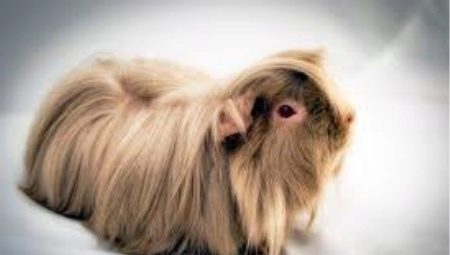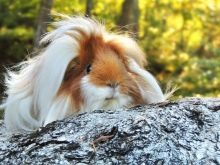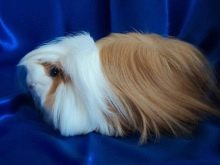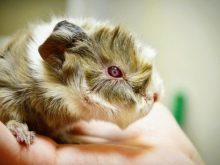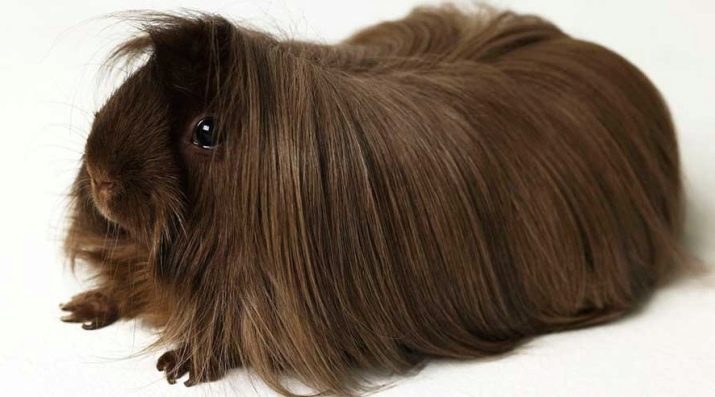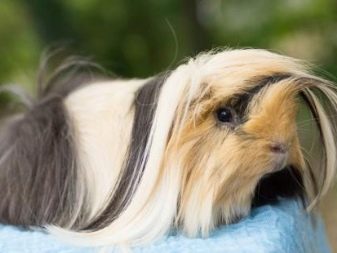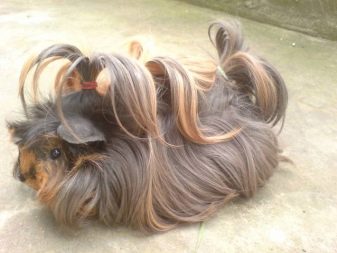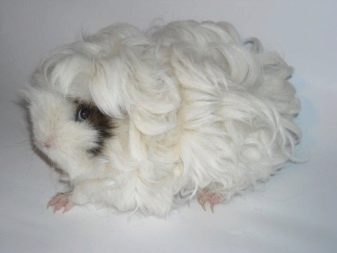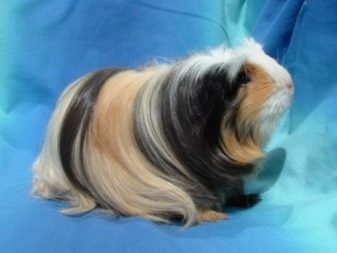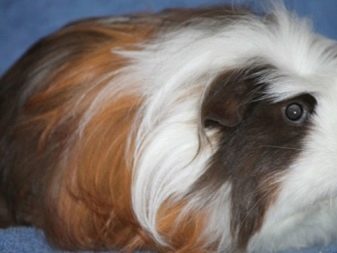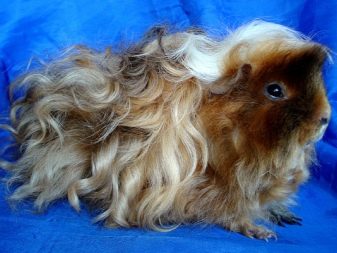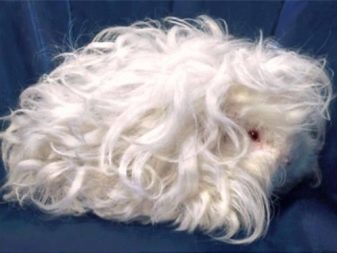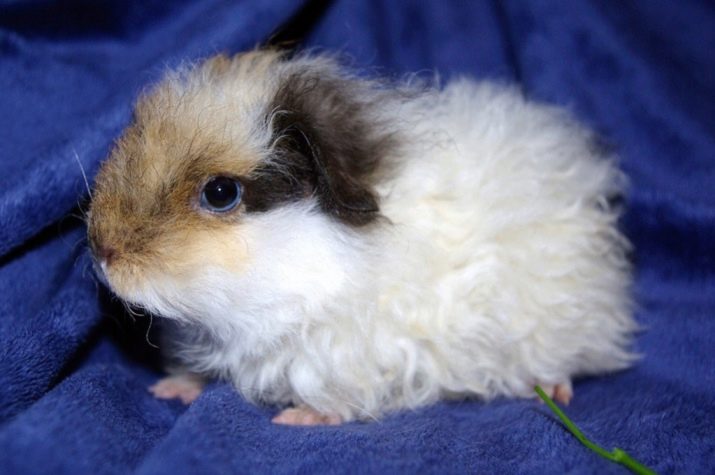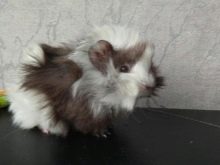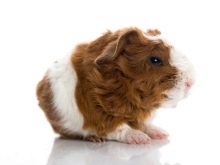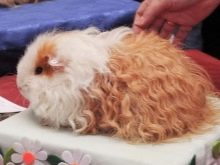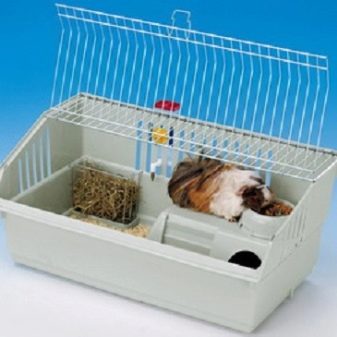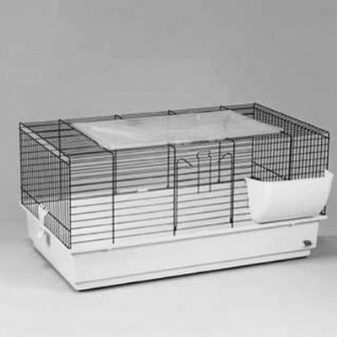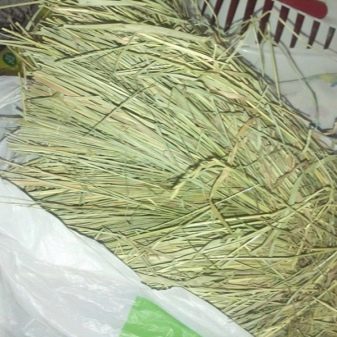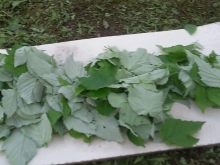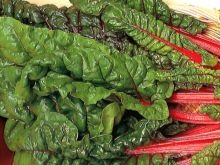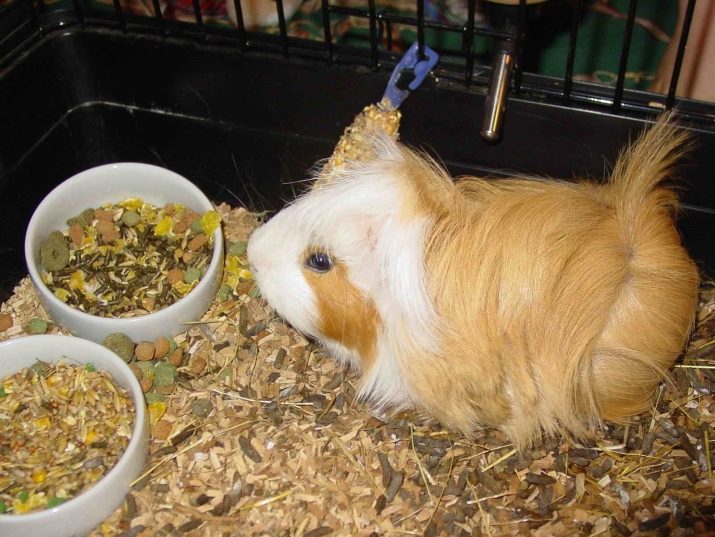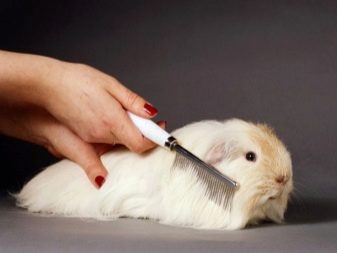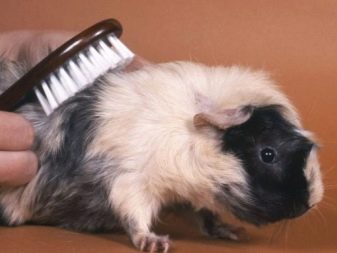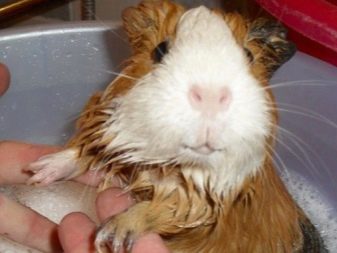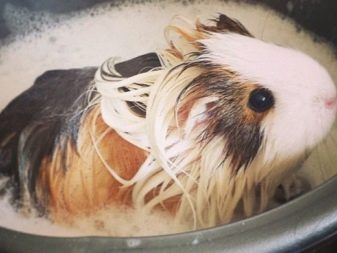Long-haired guinea pigs were born thanks to the efforts of breeders - in nature there are only individuals covered with short hair. The length of the "hair" of these charming rodents reaches 20-45 cm, and the main purpose of animals is to demonstrate themselves at various exhibitions and to touch their breeders.
Description
In the long-haired guinea pig, the oval body, which smoothly passes into a rounded face, while the profile can be safely called "Greek", since the nose and the forehead here are one whole. The ears of a shaggy guinea pig are very funny - folded with an envelope, they can be flattened to the head or be sticking out, eyes are dark, they look like beads.
Both the lower and upper incisors have no roots, grow throughout life, are sharpened by food. Paws shortened, four fingers on the front, but on the back - only three, the tiny tail is unobtrusive. The weight and dimensions of the animal depend solely on the species, but on average such a rodent can grow up to about 25-30 cm, an adult male weighs about 1.5 kg, and the mass of the female is usually 0.8-1.3 kg.
Long hair covers not only the body, but also the head of the pig, the colors can be very diverse, including mono- and polychrome colors.
The most common gamut is considered to be reddish-brown with various types of shades and blotches, but less often than the rest one can come across a tortoiseshell-colored animal. By the way, rodents with such an exclusive coloring are usually born exclusively within the same breed, and the most unusual three-color pattern is obtained by crossing at least 100 rodents among themselves.
Guinea pigs with elongated fur are completely different from each other - there are individuals with long locks, curly rodents are no less common. Fur can vary in structure, direction of growth, as well as the presence or absence of shaggy whiskers, all kinds of bangs and sockets.
Life expectancy of an animal does not exceed 6-8 years, the strongest specimens in comfortable conditions can live a decade, but, as practice shows, on average, these animals live 4-5 years.
Varieties
Among the long-haired varieties of guinea pigs, there are several of the most popular, which differ in their decorative appearance and rather extraordinary character.
Alpaca
This breed was the result of experiments by American breeders, the animals received their name due to a rather thick cover - it can even be compared with the fur of valuable lamas.
Main characteristics:
- males weight - 0.9-1.2 kg;
- the mass of females - 0.6-0.8 kg;
- the length of the torso of males is about 20 cm;
- the length of the torso of females - 17-18 cm;
- fur length - 10-15 cm;
- colors - black and white, Himalayan, brown.
Life expectancy is about 5-7 years, quite rare, but still there are 8-year-old individuals.
A characteristic feature of this breed is the peculiar growth of wool. Reaching a certain length, the hairs curl upward, and the rodent takes on a rather amusing appearance, somewhat resembling a caricature of an aristocrat.
Coronet
The breed was selected by a breeder from the UK in the 70s of the last century, the peculiarity of these animals is the similarity of a crown on a small head, the hair of rodents grows in a special way, as if forming an elongated rounded comb.
The head is rather wide, but short, eyes bulging, widely spaced, ears resemble rose petals, stick upwards. The body is quite compact, dense, well-knit. The coat is smooth, with a clearly defined texture, the density is uniform in all areas, the animal may be two or three-colored. These shaggy pigs live for about 5 years.
Luncaria
Luncaria is the most original of all artificially created breeds. This is another long-haired guinea pig, whose hair can neither be combed nor straightened. Even after thoroughly combing and treating with conditioning agents, it still almost immediately blends into corkscrew curls that perfectly hold the shape. Thanks to this feature, no debris clings to the fur.
Merino
Another English breed that won the hearts of breeders due to its rather long curly hair, which makes the animal look like a miniature lamb.
The animal is distinguished by a long curly hair of the most variable color, the head is rather wide, round, nose with a small crook. The mass of an adult animal is 1 kg. Such pets live about 4-5 years. The breed is very popular in England, it is not surprising, because In addition to the exotic appearance, these animals also have a very calm character, unpretentiousness to the conditions of their content, and are distinguished by unpretentiousness in food.
Peruvian
This breed was bred in the countries of the Old World as early as the beginning of the 19th century, where it quickly gained incredible popularity due to its external resemblance to Yorkshire terriers, but in a miniature version. The length of animal hair is about 50 cm, a straight parting is arranged along the spine line, and an elongated bang closes the wide muzzle of a rodent.
In the area of the sacrum there are two pronounced rosettes of irregular shape, the body is oval, rather dense, the humeral girdle is widened, the back is level, the head is small but well developed. There are small beady eyes, ears of the most standard form, slightly hanging down. Color can be very different, the size of the body is about 35-40 cm, weight - up to 1.5 kg. They live in captivity for about 5 years, they are completely undemanding to the conditions of detention, although caring for long hair requires a certain skill.
Texel
The breed was obtained in the late 80s of the last century, but received scientific recognition only in 1999. The length of the hairs of rodents varies from 12 to 18 cm, the color can be very diverse, the body is compact, strong, with well-developed muscles: broad shoulders, powerful chest cage and straight back. The head is strong, rounded, medium in size, moreover the nose is also of medium length, with a slight crook.
The ears are quite fleshy, paws shortened, straightened. The body length reaches 25-35 cm, the mass of an adult individual is about 1.7 kg. Usually representatives of this breed are used for display at exhibitions or for the purpose of crossing.
Guinea pigs are distinguished by a rather positive and calm character without a single manifestation of capriciousness and excessively strict requirements for the conditions of their content.
Sheltie
The first representatives of the Sheltie breed were introduced almost a hundred years ago. These pigs are characterized by soft thick and silky hair of various shades, the trunk is compact and strong, the head is short, round in shape, the eyes are black, bulging, the ears are slightly down. The form is standard, the animal is bred mainly for demonstration at exhibitions, because in everyday life it requires special care.
The fact is that the hair of this pet will have to constantly care for, otherwise, the species of rodent will be very unpresentable.
How to choose a cell?
Long guinea pigs are fairly harmless animals, they are very sociable, love to play, do not bite, and seem to be ideal for children's fun.Nevertheless, in a family where young children live, it is better not to accept them, because babies can not measure their physical strength and break the fragile spine of a rodent. Do not tolerate a pet and intimacy with domestic cats, dogs, ornamental rats and feathered pets, but the pet rabbit will be the perfect neighbor for them.
Most often such pigs live in same-sex couples. - males are friends with each other, and females breed young together. For proper growth and development they need a properly selected cell. For one rodent you need an open-air cage with a size of at least 60x40x40 cm, respectively, if there are several animals, the dimensions must be increased.
The cage should certainly be roomy, usually it is placed away from direct sunlight and drafts, and placement near air conditioners, radiators, and other climate control devices is undesirable.
The cage must be equipped with everything necessary to maintain the normal life of the pet.
- Drinking bowl It can be purchased at the pet store, the size and shape do not matter, because for the most part the product is standardized.
- Manger. In other words, the feeder. It is advisable to purchase a plastic product, because in this case it will be much easier to wash and clean the dirt. A ceramic fixture is also suitable, but a wood model is out of place here - the wood not only absorbs odors and moisture, but also is bitten by animals.
- Sepia. Sepia is established for the necessary grinding of teeth - it is a solid mineral stone, if it is not in the aviary, then the guinea pig will start to grind its teeth about any object it finds in the way.
- Twigs. These are the sprouts of fruit trees, linden and many others, their main task is to distract the animal from the constant desire to bite the furniture in the house or wooden accessories. At the same time, the presence of sepia does not exclude the needs of the animal in the branches.
- House In it, rodents hide from the hot sun or use it as a shelter. It is best to acquire a cage with a ready-made house.
- Tray with shavings or sawdust. It is used by rodents instead of a toilet, the litter can be changed every 2-3 days, while no smell appears in the room. Wood has the ability to absorb odors and excess moisture, so using sawdust eliminates the need for additional disinfection tray.
Drinking bowls and feeders should be washed every day; bedding should be replaced every 2-3 days.
Traditionally, guinea pigs are awake during the day, and at night they sleep soundly. To compensate for the lack of movement, you should release the animal for a short walk through the house. In the warm season, the animal is taken with him to a country house or a vegetable garden, where he is equipped with a small enclosure made of metal mesh - it is advisable to place him in the shade.
Nutrition
Long-haired guinea pigs are herbivores, so the food should be primarily vegetable, The following combination is considered optimal:
- grass or hay - 60-65%;
- succulent feed - 30%;
- dry food - 5%.
It is best to purchase hay in a specialty store, in which case you can be sure that it will be of good quality. When buying from the market, you may encounter irresponsible sellers who, when harvesting fodder, did not remove poisonous grasses or were harvesting near highways and large industrial facilities.
The need for feed in a shaggy guinea pig is 150 g per day. You can give her dill, parsley, lettuce leaves, pigs love strawberries, pears and cherries, they will not give up vegetables, especially they like carrots, cabbage or zucchini.
Try to keep your pet's food as varied as possible; your body should receive a full range of vitamins, macro and micronutrients. If a pet eats one cabbage or carrots, it will adversely affect its overall well-being.
The ideal situation would be when in the daily diet of a rodent there are at least 3 types of vegetables and juicy greens. As the last you can take the leaves of strawberry, raspberry, black and red currants, carrot and beet tops are very useful animals.
In the aviary should always be hay - it is involved in grinding teeth, and also contributes to the regulation of the digestive process.
We pay special attention to the fact that rodent requires salt, so it will be necessary to buy salt stone. Unfortunately, with other products the pet will not be able to get the required amount of salt, while it is very important for normalizing the digestive process.
An animal should not be hungry - if it does not receive feed for more than 18 hours, the body starts irreversible pathological changes that can cause the death of a rodent.
It is strictly forbidden to feed animals with cheese, confectionery, meat and citrus. Over-ripe and spoiled fruit should also be discarded.
As for feeding, here you need to focus on the succulence of the main feed. If the pig gets enough liquid from food, it may not drink water at all. On average, an adult pet needs 60-70 ml of water a day. Few people know, but the rodent organism is not capable of assimilating vitamins B and K at the very first passage of food, therefore many animals often eat their own feces, because when they pass through the digestive organs, all substances are already absorbed in full.
Subtleties of care
Guinea pigs are quite unpretentious, the main difficulty in the care of a rodent is in the processing of wool in order to avoid its strong entanglement. The pig must be brushed 3-4 times a week.
In order not to have to pull the hairs, it is better to sprinkle them with water from a spray bottle. Keep in mind that you can start combing only after complete removal of mats. If the hair of the animal is too long and thick at the same time, then by the summer you can cut the pet a little. Also, wool is sheared in nursing females, but not completely, but only the areas near the nipples.
From time to time, the guinea pig needs to be bathed with a special shampoo for animals, after which it is soaked with a warm towel and dried with a hairdryer (keep it away so that too hot air does not burn the little animal).
Some breeders curl the hair of their rodents on papilotki, thus, the animal gets the opportunity to move briskly, and the hairs do not roll off and do not get dirty. The ears of a hairy rodent are carefully cleaned with cotton flagella, the eyes are treated as necessary and the sharp claws are cut.
Every breeder should understand that the health of pets in the first place depends on the correctness of the diet. Its imbalance leads to rickets, scurvy, obesity, manifestations of allergies and cardiovascular diseases.
Pathologies of non-infectious origin can also include:
- cold, quickly turning into bronchitis and pneumonia;
- keratitis and acute conjunctivitis;
- otitis;
- epilepsy;
- baldness;
- cystitis;
- malignant tumors.
The most common viral infections are:
- plague;
- paralysis;
- pseudotuberculosis;
- amebiasis;
- toxoplasmosis;
- trichomoniasis;
- salmonellosis;
- enteritis;
- herpes;
- ringworm.
A rodent immediately testifies to any ailment by its refusal to eat (once again we remind of the inadmissibility of a hunger strike for more than 18 hours). Therefore, at the first signs of the disease should immediately seek medical help.
Also keep in mind that due to physiology, any injury or fall can lead to the death of a fluffy pet.
The rules for the care of the long-guinea pig are discussed in the following video.
